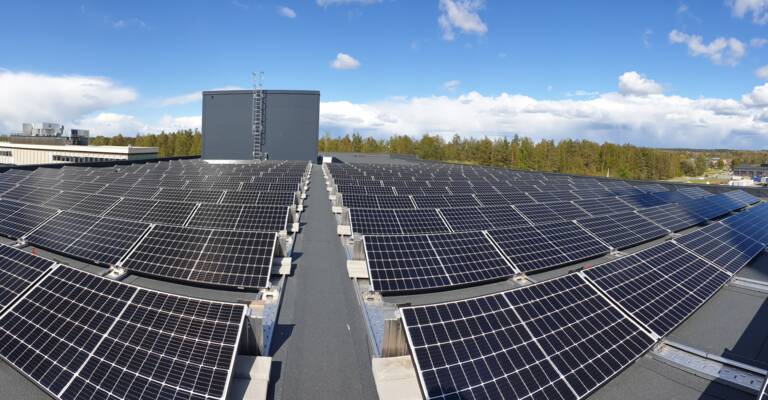In logistics, more sustainable solutions need to be developed, and one of them that is moving quickly is electrification. At the moment two battery solutions are dominating the material handling industry: lead-acid and lithium-ion batteries. And an alternative energy solution to power lithium-ion batteries is currently picking up speed as well: solar energy.
New technologies within lithium-ion
Technologies within lithium-ion are developing quickly: using new chemistries and software intelligence, battery modules can be built to avoid equipping forklifts with a big battery pack. This flexibility offers a range of new possibilities. Machines can be redesigned to become lighter, smaller, and more energy-efficient.
When we look at the lifecycle that modularised battery solutions offer, we can distinguish different lives:
- First life: the battery is manufactured and is integrated into an electric forklift
- Second life: as the battery outlives the forklift thanks to the optimised battery system, a new system can be rebuilt out of the battery components
- Third life: power banking
- Fourth life: valuable metals and other components from the battery are reused

Power banking
One limitation that can occur when working with electric vehicles is when the forklift fleet consists of a large number of machines, but there is only a limited amount of electricity that can be supplied by the building. Since lithium-ion-powered trucks benefit from opportunity charging (recharging regularly in small amounts without letting the battery run low), the electricity needs to be balanced and available throughout the shifts.
A solution for this is power banking: by storing electricity, peak power can be levelled out, and customers can opt to buy power at times that are more cost-efficient (for example, during night time), or use solar power.
Rooftop solar power
So why rooftop solar power? Simply put: solar will help us save the environment while creating savings on the electricity bill. Solar is at a tipping point today. According to World Energy Outlook 2019 (International Energy Agency), solar accounts for more than 40% of newly installed power capacity globally over the last two years, at a cost below market prices in most countries.
Companies install rooftop solar to secure cheaper electricity in order to save money from day one, and also to increase price certainty with a long-term hedge against price volatility. To lock the electricity cost at a predictable level for the long-term in an increasingly volatile market has become a more and more attractive alternative.
Another reason solar energy is interesting for companies, is the shift in the market in an increasingly climate-focused world. Companies want to be leaders in corporate citizenship and demonstrate environmental leadership, making sustainability a priority by striving towards zero emissions. Instead of just buying green electricity from the grid, companies want to take the next step and achieve a more direct sustainability impact by enabling the production of that new green electricity as addition to the energy mix.

Power banking as a key enabler
The main drawback of solar power is that, without the possibility to store the electricity, it is limited to daytime when the sun is shining. By pairing it with power banks, however, solar electricity production and consumption no longer have to take place simultaneously. This way the size of the solar installation can be maximised to cover a larger share of the total electricity consumption on site, maximising both the savings and sustainability value.
The solar market
In Europe, the solar market experienced more than 100% growth last year, and it doesn’t look like it will decelerate any time soon.
Besides the increased focus on sustainability, a key driver behind this development is of course the improving cost-competitiveness. In only ten years the average price of solar panels has dropped by 90% (source: Lazard). Improved and fully standardised system design in combination with digital operation and maintenance further underpins the cost-competitiveness and market growth.
Another driver behind the rapid growth of the European solar market has been the solar-as-a-service model called PPA (“Power Purchase Agreement”). This business model lets companies access the benefits of switching to solar without any hassle, risk, or the need to bind their own capital. In a PPA, the supplier finances, builds and operates the solar power system and the customer buys the electricity produced, typically over 10-25 years. The solar power system can either be located on the customer’s roof, or at an off-site location (“solar park”). This results in a long-term partnership that creates customer value for the coming years for the supplier, and that in turn offers the customer new value creation, as they know what is taken care of for them in the coming years.
So what does the future hold in this field? With the flexibility of storage and the computational power of machine learning, the next step for this market is to take the as-a-service model all the way and be able to guarantee a bottom-line effect in terms of savings for the customer. The data is there today, and the work to be done now is to add data analysis and digital tools, to be able to optimise and predict customer saving. We are not here today, but once it happens it will positively disrupt energy markets, and allow us to further accelerate the journey to zero emissions.






